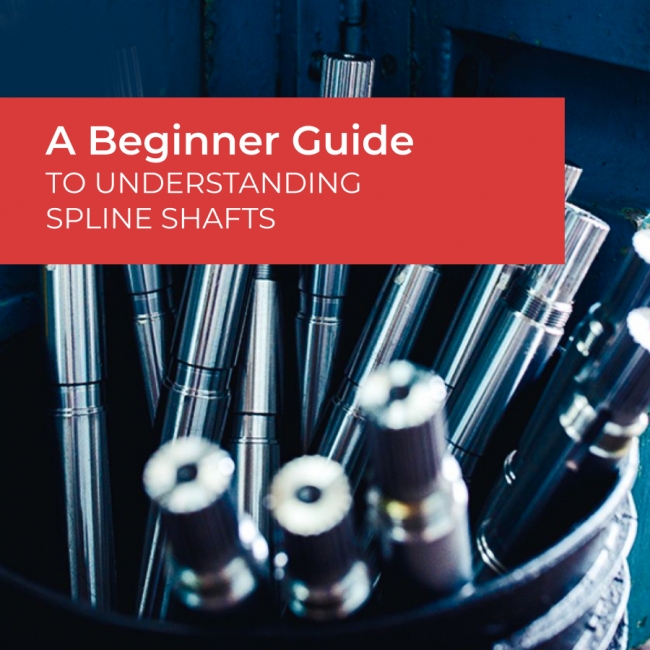Keep up to date with us on the latest industry news as well as what's going on at True Gear & Spline Ltd. We also post articles for insider tips and tricks, so make sure to check back frequently.
A Beginner Guide To Understanding Spline Shafts

The mechanical world is intricate and increasingly interrelated. In such an interdependent setting, even the tiniest component plays a crucial role. This is why none of the components can be subpar as it risks affecting the seamless functioning of the entire unit. We all know the importance of gears and the role they play in the smooth functioning machinery. However, there is another crucial component that is not talked about much. We are talking about splined shafts. These unsung heroes quietly enable power transmission and rotational movement in various machines and equipment. Spline shafts sometimes don't get the attention they deserve because they aren't as flashy as some other components. It won't be an overstatement to say that splined shafts are the backbone of countless applications, ensuring smooth and efficient operation across multiple industries. Since most people are unaware of the fundamentals of spline shafts, we have prepared a detailed guide. Read this beginner guide to spline shafts until the end to get a better understanding of these mechanical components.
What Is A Splined Shaft?
We have explained that a spline shaft plays an important role in facilitating torque transfer, but what exactly is it? It is essentially a cylindrical rod with ridges on it. These ridges are also known as teeth and they run along the length of these cylindrical rods. shafts play a crucial role in various mechanical systems, but what exactly are they? A splined shaft is essentially a cylindrical rod with a series of ridges or teeth running along its length. Depending on the type of the shaft, the teeth can be internal or external. The teeth of these shafts are usually interlocked with another shaft or gear to provide effective torque transmission.
What Are The Functions of Splined Shafts?
As mentioned earlier, the most important application of these shafts is to facilitate torque transmission between mechanical components. The splines, ridges, or teeth on the shafts are designed to provide a secure connection with grooves or slots in other parts. The strong and secure connection ensures that there is no slippage and that there is an efficient transfer of rotational force.
The importance of a secure connection between the shaft and corresponding slots cannot be stressed enough. Slippages can bring the entire mechanical functioning of a machinery to stand still. Since time is money for modern businesses, such an issue can lead to huge monetary losses.
There are more functions of splined shafts than just offering transfer torque transmission. Apart from torque transfer, spine shafts ensure accurate positioning and alignment of mechanical components. The accurately cut ridges of the shafts guarantee accurate indexing. Without correct indexing, the interconnected parts of mechanical components cannot be properly aligned.
Facilitating a seamless axial movement is another crucial function of spline shafts. Strong and durable spline shafts accommodate axial movement between interconnected components. What's more? Spline shafts can equally distribute the load throughout the length of the shaft. This enables the shafts to have exceptional load-bearing capability, making them ideal for heavy-duty applications.
How Are Splined Shafts Manufactured?
There are numerous manufacturing practices used by spline manufacturers to achieve the best results. We list below some of the most common spline shaft manufacturing practices.
Broaching
One of the most common methods used in manufacturing spline shafts is the broaching method. In this method, a broach, a toothed cutting tool, is used to remove material from the workpiece. The cutting tool is either pushed or pulled to remove material from the workpiece. Broaching uses a multi-toothed tool called a broach, which is pushed or pulled through the workpiece to remove material and create the desired shape. The process involves several steps like preparing the workpiece, mounting the broach, making the initial cut, heat treatment, and applying final finishing touches.
Shaping
Shaping is one of the most common gear and spline manufacturing techniques. The use of CNC shaping machines is a prevalent industry practice. In this manufacturing process, two shafts are continuously meshed until the desired shape is achieved. It is one of the simplest and most effective gear and spline manufacturing techniques.
Milling
Milling is one of the oldest spline manufacturing techniques. In this method, a rotating cutter is used to remove material from the workpiece to create the desired shape. The milling machine has a rotary cutting tool that moves along multiple axes, allowing for more complex shapes and designs to be created. The process involves setting up the workpiece and fixing it in place, then using a milling machine to cut away material and create the spline shape.
Grinding
This is a rather simple manufacturing technique. In this method, an abrasive grinding wheel rotates and grinds against the workpiece. The grinding wheel removes material from the workpiece in a controlled manner, thus helping cylindrical shafts achieve the desired shape. Grinding is apt for custom spline shaft manufacturing where precise finishes are required.
Conclusion
Splined shafts are an invaluable element of mechanical units. To reap their maximum benefit, however, you need to source them from a trusted manufacturer like True Gear & Spline Ltd. We have decades of experience manufacturing the best splines and gears. Our team of skilled engineers and technicians is dedicated to providing precision-engineered solutions that your expectations. Call us today for all your custom splined shaft and gear manufacturing needs.








